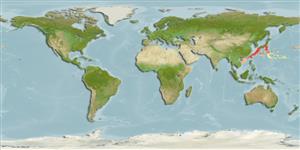Common names from other countries
Environment: milieu / climate zone / depth range / distribution range
экология
морской батидемерсальный; пределы глубины 500 - 1985 m (Ref. 7460). Deep-water; 35°N - 34°S, 102°E - 153°W
Northwest Pacific: Japan and Taiwan; most probably in East China Sea and/or the Okinawa Trough, but rarely in the South China Sea. No reliable reports outside this area and need to be checked.
Size / Вес / Возраст
Maturity: Lm ? range ? - ? cm
Max length : 14.0 cm SL самец/пол неопределен; (Ref. 559)
A species belonging to the C. fimbriatus species group which is distinguished mainly from its congeners by having two large pale patches on its dorsal surface, one associated with the embedded third dorsal spine and another before the origin of the soft dorsal fin; mainly four neuromasts in the lower preopercular series (vs. mainly 3 in other congeners) (Ref. 94130).
Benthic (Ref. 58302). Edible (Ref. 637).
Life cycle and mating behavior
половая зрелость | размножение | нерест | икра | Fecundity | личинки
Masuda, H., K. Amaoka, C. Araga, T. Uyeno and T. Yoshino, 1984. The fishes of the Japanese Archipelago. Vol. 1. Tokai University Press, Tokyo, Japan. 437 p. (text). (Ref. 559)
Статус Красного Списка МСОП (Ref. 130435)
CITES (Ref. 128078)
Not Evaluated
Угроза для людей
Harmless
Использование человеком
дополнительная информация
ссылкиаквакультура (рыбоводство)особенности рыбоводствастепень растяжениягенетикаElectrophoresesнаследуемостьболезниобработкаMass conversion
инструменты
Специальные отчеты
Скачать в формате XML
ресурсы в Интернет
Estimates based on models
Preferred temperature (Ref.
115969): 3.5 - 6.5, mean 4.6 (based on 54 cells).
Phylogenetic diversity index (Ref.
82804): PD
50 = 0.5000 [Uniqueness, from 0.5 = low to 2.0 = high].
Bayesian length-weight: a=0.01122 (0.00514 - 0.02450), b=3.04 (2.87 - 3.21), in cm Total Length, based on all LWR estimates for this body shape (Ref.
93245).
Trophic level (Ref.
69278): 3.9 ±0.7 se; based on size and trophs of closest relatives
Fishing Vulnerability (Ref.
59153): Low vulnerability (10 of 100).
